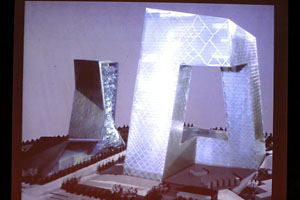Architect Rem Koolhaas warns of the 'sloppy' and 'uncritical'
By Liz Holmes

ITHACA, N.Y. -- Internationally famed architect Rem Koolhaas spoke to an overflow crowd in Kennedy Hall's 600-seat David L. Call Alumni Auditorium on the Cornell University campus April 25. The 2000 winner of the Pritzker Prize -- often called the Nobel Prize of architecture -- talked about his views of the current state of architecture in general and also described, and showed images of, projects of his own. His talk and visit were sponsored by Cornell University's College of Architecture, Art and Planning (AAP).
Some in the crowd, which included a number of people from Syracuse as well as the Cornell and Ithaca communities, had to stand in the rear or listen from outside the auditorium doors, as Koolhaas gave a relaxed and sometimes humorous lecture and slide presentation. It was, as one Cornell architecture student said, "definitely one of the most anticipated lectures of the year."

Architecture today, Koolhaas said, is deeply affected by globalization and by its dependence on private rather than public commissions. Architects "used to be good because we were servants of the public. Now we're the servants of private interests. ... That shift needs to be understood."
Speaking of the trend toward dramatically shaped buildings, Koolhaas observed that cities are "stuck with a series of buildings that are supposed to be exceptional, but the way they perform is inferior to their effect." Whether it's the extravagance of the "Bilbao effect," said Koolhaas -- referring to the undulating surface of Frank Gehry's Guggenheim Museum in Bilbao, Spain -- or the "sobriety" of the newly expanded Museum of Modern Art in New York City, he said, "the public receives both with equanimity."
"The most pernicious part of the Bilbao effect is that even major cities lose confidence and think they need extravagant buildings to remain interesting," Koolhaas said. He warned of the danger of architecture becoming "sloppy, uncritical. It's received with an enormous amount of attention and a negligible amount of seriousness."
Koolhaas, who studied architecture at Cornell in the early 1970s, was introduced by AAP dean and architect Mohsen Mostafavi. "No architect has had a more profound effect on the world of architecture in recent years," Mostafavi said. "Not only his buildings but his books have made an enormous contribution to the discourse of architecture." Koolhaas is the author of "Delirious New York, a Retroactive Manifesto for Manhattan" (1978) as well as "S, M, L, XL" (1995), on the work of the Office for Metropolitan Architecture (OMA), which he co-founded.
Koolhaas continues to head OMA, which has offices in Rotterdam, New York City and Beijing. He also leads OMA's research branch, AMO, whose aim, he said in his lecture, "is to experiment with the notion that architectural thinking is worth a lot." Recent AMO projects include image restructuring for Condé Nast magazines Lucky and Wired and a study on the future of the automobile for Volkswagen.
Koolhaas also is a professor at Harvard University, where he directs the Project on the City, a research program investigating changing urban conditions around the world.
Among the recent OMA projects that Koolhaas discussed was the Casa da Musica concert hall in Porto, Portugal, described in The New York Times on April 10 as a building "whose intellectual ardor is matched by its sensual beauty" as well as "one of the most important concert halls built in the last 100 years." Koolhaas described the process of generating the ideas for the building's shape -- a narrow base, broader at higher levels, with irregular volumes surrounding what he called the "shoebox" shape of the hall itself.
Koolhaas also spoke about other notable OMA projects, including the Dutch embassy in Berlin and the China Central Television building in Beijing.
Media Contact
Get Cornell news delivered right to your inbox.
Subscribe